Read and download free pdf of CBSE Class 11 Accountancy Financial Statements Worksheet Set B. Students and teachers of Class 11 Accountancy can get free printable Worksheets for Class 11 Accountancy Chapter 8 Financial Statements in PDF format prepared as per the latest syllabus and examination pattern in your schools. Class 11 students should practice questions and answers given here for Accountancy in Class 11 which will help them to improve your knowledge of all important chapters and its topics. Students should also download free pdf of Class 11 Accountancy Worksheets prepared by teachers as per the latest Accountancy books and syllabus issued this academic year and solve important problems with solutions on daily basis to get more score in school exams and tests
Worksheet for Class 11 Accountancy Chapter 8 Financial Statements
Class 11 Accountancy students should download to the following Chapter 8 Financial Statements Class 11 worksheet in PDF. This test paper with questions and answers for Class 11 will be very useful for exams and help you to score good marks
Class 11 Accountancy Worksheet for Chapter 8 Financial Statements
Short Answer Type Questions :
Question: Discuss the need of preparing a balance sheet.
Answer: The need and importance of preparing a balance sheet is stated in the following points
(i) It helps to ascertain the true financial position of the business at a particular point of time.
(ii) It helps in ascertaining the nature and cost of various assets of the business such as the amount of closing stock, amount owing from debtors, amount of fictitious assets, etc.
(iii) It helps in determining the nature and amount of various liabilities of the business.
(iv) It gives information about the exact amount of capital at the end of the year and the addition or deduction made into it in the current year.
(v) It helps in finding out whether the firm is solvent or not. The firm is solvent if the assets exceed the external liabilities. It would be insolvent if opposite is the case.
(vi) It helps in preparing the opening entries at the beginning of the next year.
Question: Calculate the amount of gross profit and operating profit on the basis of the following balances extracted from the books of M/s Rajiv and Sons for the year ended 31st March, 2020.
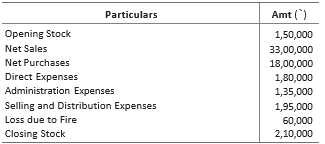
Answer:

Operating Profit = Gross Profit − (Operating Expenses* + Operating Income)
=13,80,000 − (3,30,000 + 0) = ₹ 10,50,000
Note (i) Loss due to fire is a non-operating expense.
(ii) *Operating Expenses = Administration Expenses + Selling and Distribution Expenses = 1,35,000 + 1,95,000 = ₹ 3,30,000
Question: From the following information, prepare trading account for the year ended 31st March, 2020.

Answer:

Note Wages has not been shown on the debit side and closing stock has not been shown on the credit side of the trading account because it has already been adjusted while calculating the cost of goods sold.
Question: What are the objectives of preparing financial statements?
Answer: The basic objectives of preparing financial statements are
(i) To present a true and fair view of the working of the business.
(ii) To help to judge the effectiveness of the management.
(iii) To provide sufficient and reliable information to various users interested in financial statements.
(iv) To facilitate efficient allocation of resources.
(v) To disclose various accounting policies.
(vi) To provide information about the cash flows.
(vii) To provide information about the earning capacity.
(viii) To provide financial data on assets (economic resources) and liabilities (obligations) of an enterprise.
Question: From the following information, find cost of goods sold and net sales.

The percentage of gross profit on sales is 20%.
Answer:
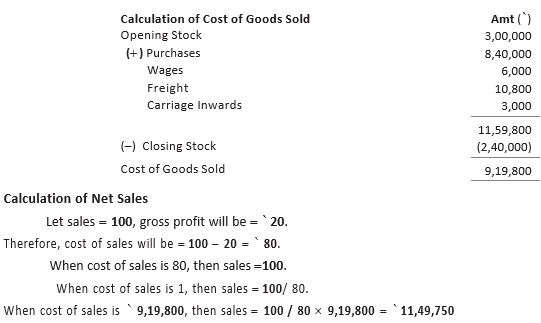
Question: Distinguish between capital receipts and revenue receipts.
Answer: The differences between capital receipts and revenue receipts are
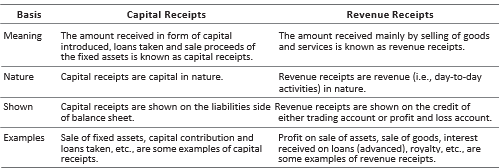
Question: From the following information, prepare a balance sheet of Mr Raghav as at 31st March, 2021. (i) in order of permanence (ii) in order of liquidity.
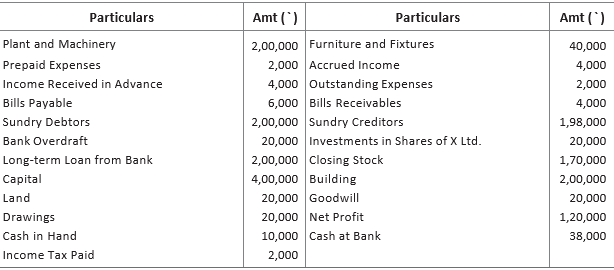
Answer:
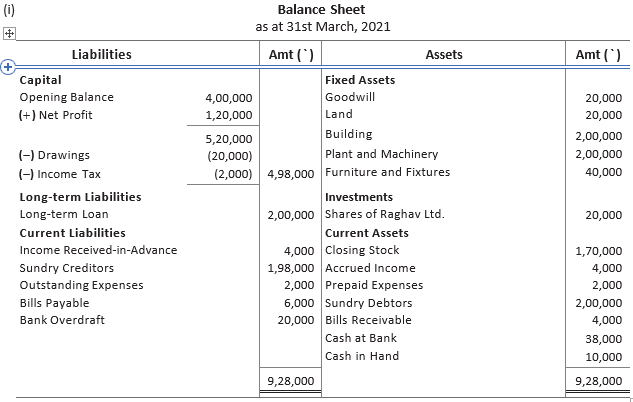
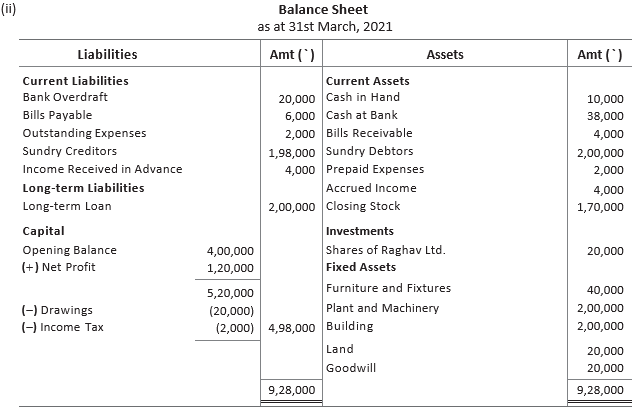
Question: Calculate the gross profit from the following for 50% goods sold. Total purchases during the current year are ₹ 9,00,000, Return outward ₹ 50,000, Lighting ₹ 30,000, Wages ₹ 80,000 and Electricity ₹ 8,000 and 1/2nd goods are sold for ₹ 8,00,000.
Answer: Cost of Goods Sold (CoGS) = Opening Stock + Total Purchases − Return Outward + Direct Expenses

Question: State whether the following statements are items of capital or revenue expenditure, with reason.
(i) Expenditure incurred on repairs and white washing at the time of purchase of an old building in order to make it usable.
(ii) Registration fees paid at the time of purchase of a building.
(iii) Depreciation on plant and machinery.
Answer: (i) Capital Expenditure Any expenditure on purchase of an asset to make it usable is capital expenditure.
(ii) Capital Expenditure Registration fee is part of cost of an asset.
(iii) Revenue Expenditure Depreciation is charged on yearly basis throughout the life of an asset.
Question: Calculate gross profit, operating profit and net profit from the following.
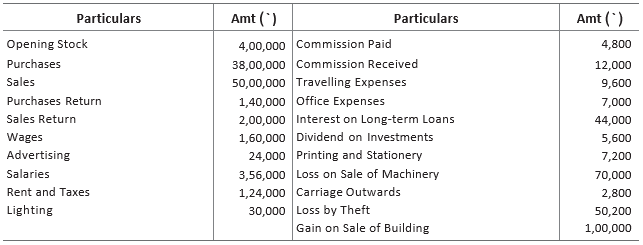
Closing stock was valued at ₹ 5,00,000.
Answer:
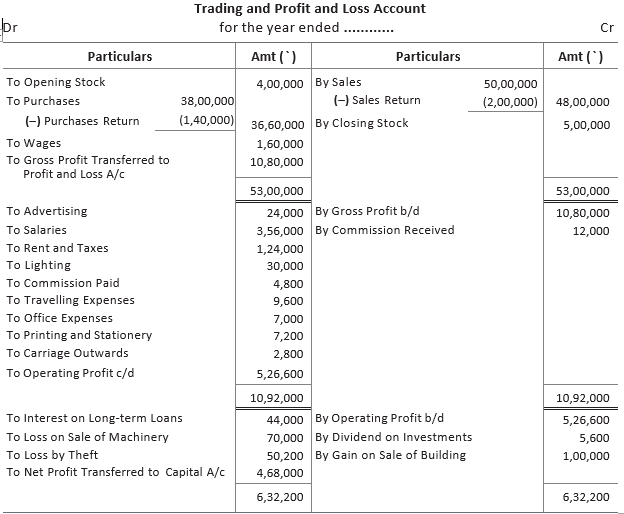
Question: Calculate gross profit from the following.

Answer: Cost of Goods Sold (CoGS) = Opening Stock + Purchases − Purchase Return + Direct Expenses − Closing Stock
= 20,000 + 3,50,000 + 3,000 − 90,000 = 3,73,000 − 90,000 = ₹ 2,83,000
Where, carriage on purchases is direct expense.
Gross Profit = Net Sales − CoGS = Sales − Sales Return − CoGS
= 6,50,000 − 10,000 − 2,83,000 = ₹ 3,57,000
Question: From the following details, calculate operating profit.
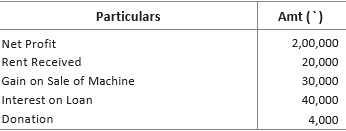
Answer:

Question: Calculate closing stock from the following details.
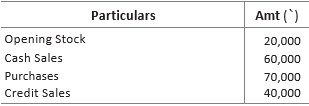
Rate of gross profit on cost 33 1/3 %.
Answer: Total Sales = Cash Sales + Credit Sales = 60,000 + 40,000
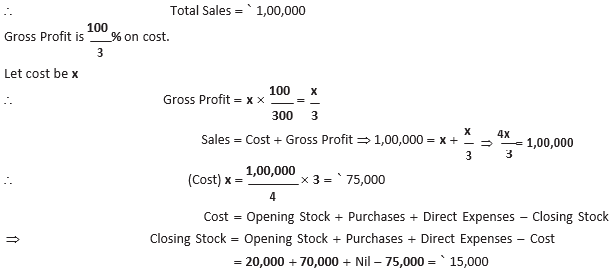
Question: What are financial statements and what information is provided by them?
Answer: Financial statements are the final/end products of an accounting process, which begins with the identification of accounting information and recording it in the books of primary entry.
Financial statements are prepared following the accounting concepts and conventions. These statements are prepared at the end of accounting period and give information about the financial position and performance of an enterprise.
Trading and profit and loss account present a true and fair view of the financial performance of the business in the form of profit and loss during the year. Balance sheet presents a true and fair view of the financial position of the business.
Question: Trading account of M/s Volvoline Technologies is given below
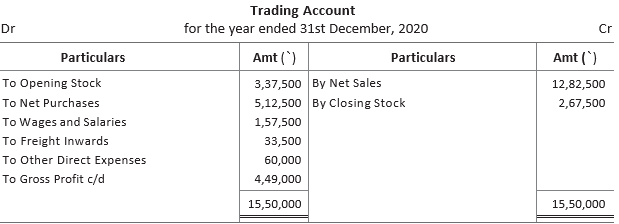
Pass closing journal entries on the basis of the above trading account. Also, transfer the gross profit to profit and loss account.
Answer:
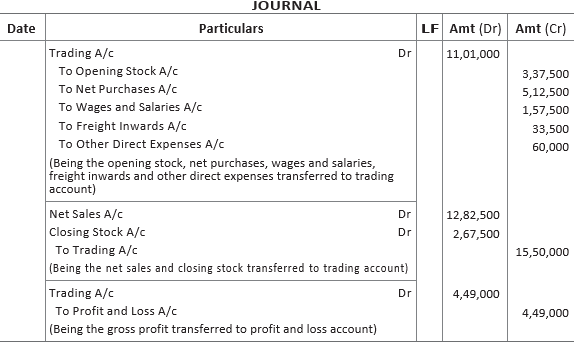
Question: What are the features of a trading account?
Answer: Features of trading account are
(i) Trading account is the first stage in the preparation of final accounts.
(ii) It provides information about gross profit and gross loss.
(iii) Balance of trading account is transferred to profit and loss account.
(iv) Trading account is a nominal account.
(v) Trading account relates to a particular accounting period and is prepared at the end of that period.
(vi) Trading account records only revenue items and not capital items.
Question: Calculate opening stock from the following details
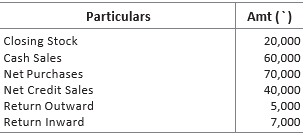
Rate of gross profit on cost 33 1/3 %.
Answer: Net Sales = Cost of Goods Sold (CoGS) + Gross Profit (GP)
Cash Sales + Net Credit Sales = CoGS + GP

Long Answer Type Questions :
Question: From the following balances of M/s Nilu Sarees as on 31st March, 2021. Prepare trading and profit and loss account and balance sheet as on that date.
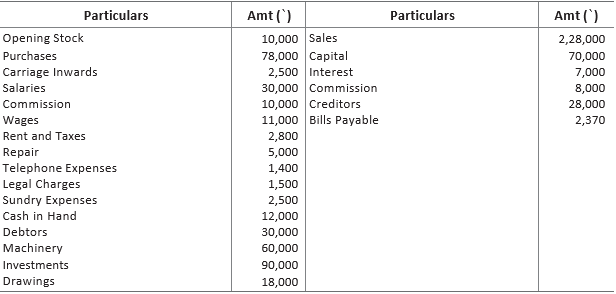
Closing stock as on 31st March, 2021 ₹ 22,000.
Answer:
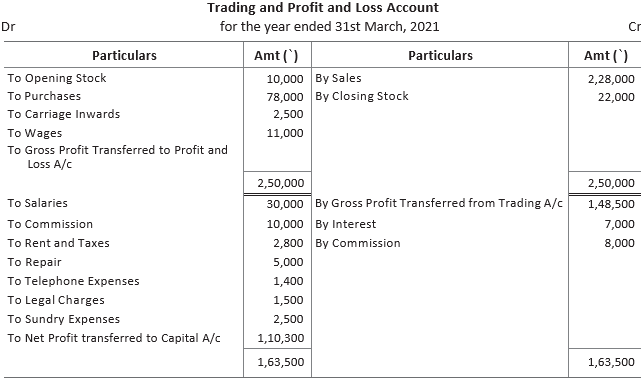
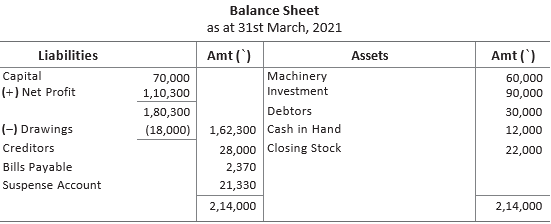
Note (i) Total of debit side of trial balance is ₹ 3,64,700 and total of credit side of trial balance is ₹ 3,43,370. The difference in credit side is ₹ 21,330.
(ii) Difference in credit side of trial balance ₹ 21,330 will be treated as liabilities and posted in liabilities side of balance sheet.
Question: Distinguish between capital expenditure and revenue expenditure and state whether the following statements are items of capital or revenue expenditure.
(i) Expenditure incurred on repairs and white washing at the time of purchase of an old building in order to make it usable.
(ii) Expenditure incurred to provide one more exit in a cinema hall in compliance with a government order.
(iii) Registration fees paid at the time of purchase of a building.
(iv) Expenditure incurred in the maintenance of a tea garden which will produce tea after 4 years.
(v) Depreciation charged on a plant.
(vi) The expenditure incurred in erecting a platform on which a machine will be fixed.
(vii) Advertising expenditure, the benefits of which will last for 4 years.
Answer: The differences between capital expenditure and revenue expenditure are
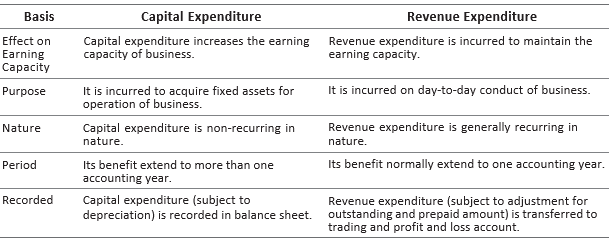
(i) Expenditure incurred on repairs and white washing at the time of purchase of an old building in order to make it usable — Capital Expenditure
(ii) Expenditure incurred to provide one more exit in a cinema hall in compliance with a government order — Capital Expenditure
(iii) Registration fees paid at the time of purchase of a building — Capital Expenditure
(iv) Expenditure incurred in the maintenance of a tea garden which will produce tea after 4 years — Revenue Expenditure
(v) Depreciation charged on a plant — Revenue Expenditure
(vi) The expenditure incurred in erecting a platform on which a machine will be fixed — Capital Expenditure
(vii) Advertising expenditure, the benefits of which will last for 4 years—Deferred Revenue Expenditure.
Question: What is a balance sheet? What are its characteristics?
Answer: The balance sheet is a statement prepared for showing the financial position of the business summarising its assets and liabilities at a given date. It is prepared at the end of the accounting period after the trading and profit and loss account have been prepared. The assets reflect debit balances and liabilities (including capital) reflect credit balances.
It is called a balance sheet because it is a statement of balances of ledger accounts which have not been closed till the preparation of the trading and profit and loss account.
Features/Characteristics of balance sheet are as follows
(i) Balance sheet is prepared at a particular point of time and not for a particular period.
(ii) It is only a statement and not an account.
(iii) It is prepared after the preparation of trading and profit and loss account.
(iv) It shows the financial position of the business.
(v) It is a summary of balances of those ledger accounts which have not been closed by transferring to the trading and profit and loss account.
(vi) It shows the nature and value of assets.
(vii) It shows the nature and amount of liabilities.
(viii) The total of assets side must be equal to the liabilities side.
Question: The following is the trial balance of Manju Chawla on 31st March, 2021. You are required to prepare trading and profit and loss account and a balance sheet as on that date.
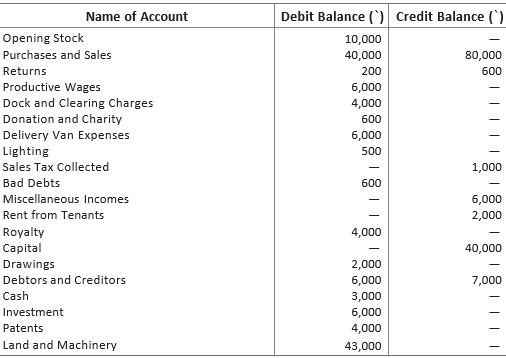
Closing Stock ₹ 2,000
Answer:
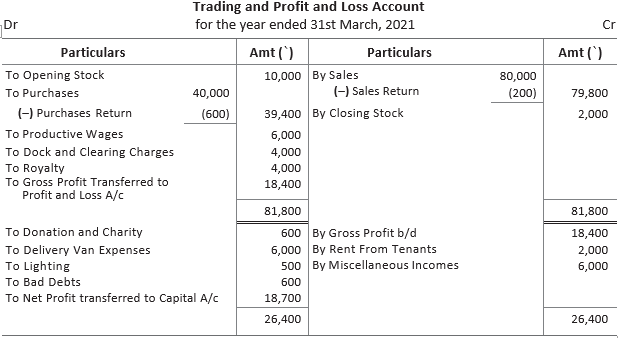
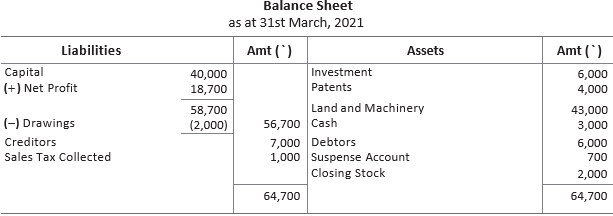
Note There is a difference of ₹ 700 in debit side of trial balance, so it will be shown in the assets side of the balance sheet.
Question: Distinguish between profit and loss account and balance sheet.
Answer: The differences between profit and loss account and balance sheet are
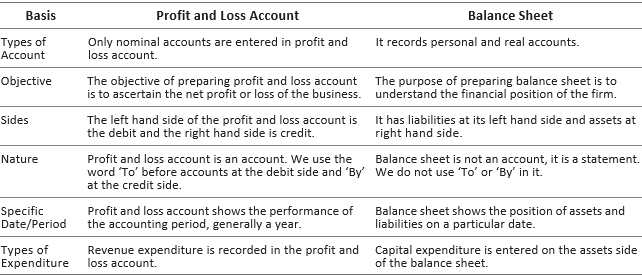
Question: The following trial balance is extracted from the books of M/s Ram on 31st March, 2020. You are required to prepare trading and profit and loss account and the balance sheet as on that date.
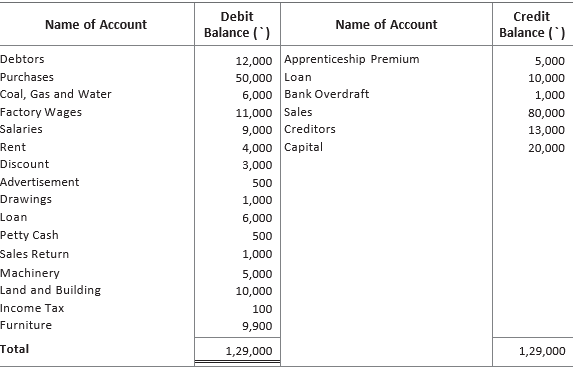
Answer:
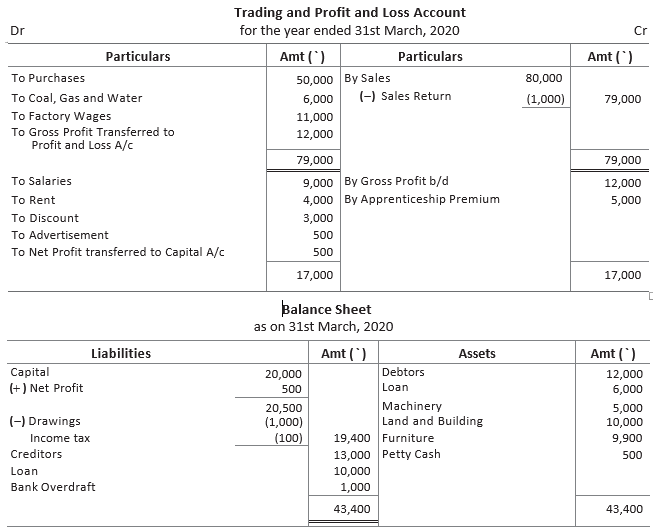
| CBSE Class 11 Accountancy Theory Base Of Accounting Enrichment Worksheet |
| CBSE Class 11 Accountancy Theory Base Of Accounting Worksheet |
| CBSE Class 11 Accountancy Subsidiary Books I Cash Book Worksheet |
| CBSE Class 11 Accountancy Subsidiary Books II Other Books Worksheet |
| CBSE Class 11 Accountancy Bank Reconciliation Statement Worksheet |
| CBSE Class 11 Accountancy Question Bank Worksheet |
| CBSE Class 11 Accountancy Rectification Of Errors Worksheet Set A |
| CBSE Class 11 Accountancy Rectification Of Errors Worksheet Set B |
| CBSE Class 11 Accountancy Depreciation Provisions And Reserves Worksheet |
| CBSE Class 11 Accountancy Financial Statements Worksheet Set A |
| CBSE Class 11 Accountancy Financial Statements Worksheet Set B |
| CBSE Class 11 Accountancy Financial Statements II Worksheet Set A |
Worksheet for CBSE Accountancy Class 11 Chapter 8 Financial Statements
We hope students liked the above worksheet for Chapter 8 Financial Statements designed as per the latest syllabus for Class 11 Accountancy released by CBSE. Students of Class 11 should download in Pdf format and practice the questions and solutions given in the above worksheet for Class 11 Accountancy on a daily basis. All the latest worksheets with answers have been developed for Accountancy by referring to the most important and regularly asked topics that the students should learn and practice to get better scores in their class tests and examinations. Expert teachers of studiestoday have referred to the NCERT book for Class 11 Accountancy to develop the Accountancy Class 11 worksheet. After solving the questions given in the worksheet which have been developed as per the latest course books also refer to the NCERT solutions for Class 11 Accountancy designed by our teachers. We have also provided a lot of MCQ questions for Class 11 Accountancy in the worksheet so that you can solve questions relating to all topics given in each chapter.
You can download the CBSE Printable worksheets for Class 11 Accountancy Chapter 8 Financial Statements for latest session from StudiesToday.com
There is no charge for the Printable worksheets for Class 11 CBSE Accountancy Chapter 8 Financial Statements you can download everything free
Yes, studiestoday.com provides all latest NCERT Chapter 8 Financial Statements Class 11 Accountancy test sheets with answers based on the latest books for the current academic session
CBSE Class 11 Accountancy Chapter 8 Financial Statements worksheets cover all topics as per the latest syllabus for current academic year.
Regular practice with Class 11 Accountancy worksheets can help you understand all concepts better, you can identify weak areas, and improve your speed and accuracy.

